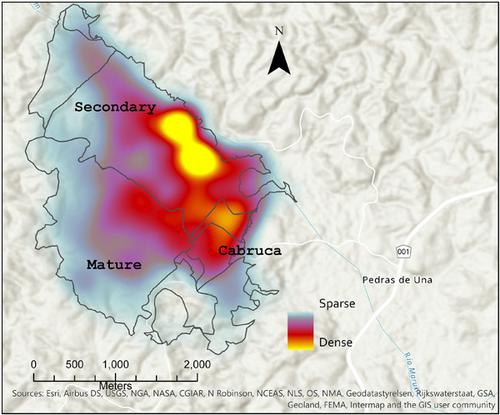当前位置:
X-MOL 学术
›
Am. J. Primatol.
›
论文详情
Our official English website, www.x-mol.net, welcomes your
feedback! (Note: you will need to create a separate account there.)
The role of hunting on Sapajus xanthosternos' landscape of fear in the Atlantic Forest, Brazil
American Journal of Primatology ( IF 2.0 ) Pub Date : 2021-03-23 , DOI: 10.1002/ajp.23243 Priscila Suscke 1 , Andrea Presotto 2 , Patrícia Izar 1
American Journal of Primatology ( IF 2.0 ) Pub Date : 2021-03-23 , DOI: 10.1002/ajp.23243 Priscila Suscke 1 , Andrea Presotto 2 , Patrícia Izar 1
Affiliation

|
Habitats with spatial variation in food availability, predation risk, and hunting pressure allow us to study how animals resolve the trade‐off between food searching and predator avoidance. We investigated the influence of food availability, predation risk, and the perceived predation risk on habitat use by a primate living under high hunting pressure, the yellow‐breasted capuchin monkeys, Sapajus xanthosternos, at Una Biological Reserve (ReBio Una). We hypothesized that the hunting pressure occurring in the capuchins' home range would favor predator avoidance to the detriment of searching for food. We characterized a set of covariates related to resource availability (fruit and invertebrate biomasses, feeding on dispersed and clumped food items, sleeping sites), perceived predation risk (alarm calls given to terrestrial and aerial predators, silent group movement, and vigilance behavior), and actual predation risk (evidence of hunting) and estimated their effects on how one group of capuchin monkeys uses its habitat. The group divides its time among three major forest types within their home range: agroforest, mature, and secondary. Our results suggest that the actual and perceived risk of hunting by humans, as well as the perceived predation risk by both terrestrial and aerial predators, were significant determinants of capuchin monkeys' space use. Yellow‐breasted capuchin monkeys' space use was negatively related to the risk of hunting by humans (actual evidence and silent behavior), the perceived risk of predation by both aerial and terrestrial predators, and the presence of sleeping sites. Capuchin monkeys' use of space was not related to the biomass of fruits in the habitat, and the biomass of invertebrates had a very low positive effect. We confirmed our prediction that in a habitat with high hunting pressure, the risk of predation, both perceived and actual, had a more significant impact on how yellow‐breasted capuchins used space than did food availability.
中文翻译:

狩猎对巴西大西洋森林 Sapajus xanthosternos 恐惧景观的作用
具有食物可用性、捕食风险和狩猎压力空间变化的栖息地使我们能够研究动物如何解决食物搜索和避免捕食者之间的权衡。我们调查了食物供应、捕食风险和感知捕食风险对生活在高狩猎压力下的灵长类动物、黄胸卷尾猴、Sapajus xanthosternos栖息地使用的影响, 在 Una 生物保护区 (ReBio Una)。我们假设卷尾猴的家庭范围内发生的狩猎压力有利于避免捕食者,而不利于寻找食物。我们描述了一组与资源可用性(水果和无脊椎动物生物量、以分散和成团的食物为食、睡眠场所)、感知的捕食风险(向陆地和空中掠食者发出警报、沉默的群体运动和警惕行为)相关的协变量,和实际捕食风险(狩猎的证据),并估计它们对一群卷尾猴如何利用其栖息地的影响。该小组将其时间分配在其家庭范围内的三种主要森林类型中:农林林、成熟林和次生林。我们的结果表明,人类狩猎的实际和感知风险,以及感知到的陆地和空中掠食者的捕食风险,是卷尾猴空间利用的重要决定因素。黄胸卷尾猴的空间使用与人类狩猎的风险(实际证据和沉默行为)、空中和陆地捕食者捕食的感知风险以及睡眠场所的存在呈负相关。卷尾猴的空间利用与栖息地水果的生物量无关,无脊椎动物的生物量具有极低的正效应。我们证实了我们的预测,即在具有高狩猎压力的栖息地中,与食物供应相比,感知和实际捕食风险对黄胸卷尾猴如何利用空间的影响更大。是卷尾猴空间利用的重要决定因素。黄胸卷尾猴的空间使用与人类狩猎的风险(实际证据和沉默行为)、空中和陆地捕食者捕食的感知风险以及睡眠场所的存在呈负相关。卷尾猴的空间利用与栖息地水果的生物量无关,无脊椎动物的生物量具有极低的正效应。我们证实了我们的预测,即在具有高狩猎压力的栖息地中,与食物供应相比,感知和实际捕食风险对黄胸卷尾猴如何利用空间的影响更大。是卷尾猴空间利用的重要决定因素。黄胸卷尾猴的空间使用与人类狩猎的风险(实际证据和沉默行为)、空中和陆地捕食者捕食的感知风险以及睡眠场所的存在呈负相关。卷尾猴的空间利用与栖息地水果的生物量无关,无脊椎动物的生物量具有极低的正效应。我们证实了我们的预测,即在具有高狩猎压力的栖息地中,与食物供应相比,感知和实际捕食风险对黄胸卷尾猴如何利用空间的影响更大。空间使用与人类狩猎的风险(实际证据和沉默的行为)、空中和陆地捕食者捕食的感知风险以及睡眠场所的存在呈负相关。卷尾猴的空间利用与栖息地水果的生物量无关,无脊椎动物的生物量具有极低的正效应。我们证实了我们的预测,即在具有高狩猎压力的栖息地中,与食物供应相比,感知和实际捕食风险对黄胸卷尾猴如何利用空间的影响更大。空间使用与人类狩猎的风险(实际证据和沉默的行为)、空中和陆地捕食者捕食的感知风险以及睡眠场所的存在呈负相关。卷尾猴的空间利用与栖息地水果的生物量无关,无脊椎动物的生物量具有极低的正效应。我们证实了我们的预测,即在具有高狩猎压力的栖息地中,与食物供应相比,感知和实际捕食风险对黄胸卷尾猴如何利用空间的影响更大。无脊椎动物的生物量具有非常低的积极作用。我们证实了我们的预测,即在具有高狩猎压力的栖息地中,与食物供应相比,感知和实际捕食风险对黄胸卷尾猴如何利用空间的影响更大。无脊椎动物的生物量具有非常低的积极作用。我们证实了我们的预测,即在具有高狩猎压力的栖息地中,与食物供应相比,感知和实际捕食风险对黄胸卷尾猴如何利用空间的影响更大。
更新日期:2021-04-29
中文翻译:

狩猎对巴西大西洋森林 Sapajus xanthosternos 恐惧景观的作用
具有食物可用性、捕食风险和狩猎压力空间变化的栖息地使我们能够研究动物如何解决食物搜索和避免捕食者之间的权衡。我们调查了食物供应、捕食风险和感知捕食风险对生活在高狩猎压力下的灵长类动物、黄胸卷尾猴、Sapajus xanthosternos栖息地使用的影响, 在 Una 生物保护区 (ReBio Una)。我们假设卷尾猴的家庭范围内发生的狩猎压力有利于避免捕食者,而不利于寻找食物。我们描述了一组与资源可用性(水果和无脊椎动物生物量、以分散和成团的食物为食、睡眠场所)、感知的捕食风险(向陆地和空中掠食者发出警报、沉默的群体运动和警惕行为)相关的协变量,和实际捕食风险(狩猎的证据),并估计它们对一群卷尾猴如何利用其栖息地的影响。该小组将其时间分配在其家庭范围内的三种主要森林类型中:农林林、成熟林和次生林。我们的结果表明,人类狩猎的实际和感知风险,以及感知到的陆地和空中掠食者的捕食风险,是卷尾猴空间利用的重要决定因素。黄胸卷尾猴的空间使用与人类狩猎的风险(实际证据和沉默行为)、空中和陆地捕食者捕食的感知风险以及睡眠场所的存在呈负相关。卷尾猴的空间利用与栖息地水果的生物量无关,无脊椎动物的生物量具有极低的正效应。我们证实了我们的预测,即在具有高狩猎压力的栖息地中,与食物供应相比,感知和实际捕食风险对黄胸卷尾猴如何利用空间的影响更大。是卷尾猴空间利用的重要决定因素。黄胸卷尾猴的空间使用与人类狩猎的风险(实际证据和沉默行为)、空中和陆地捕食者捕食的感知风险以及睡眠场所的存在呈负相关。卷尾猴的空间利用与栖息地水果的生物量无关,无脊椎动物的生物量具有极低的正效应。我们证实了我们的预测,即在具有高狩猎压力的栖息地中,与食物供应相比,感知和实际捕食风险对黄胸卷尾猴如何利用空间的影响更大。是卷尾猴空间利用的重要决定因素。黄胸卷尾猴的空间使用与人类狩猎的风险(实际证据和沉默行为)、空中和陆地捕食者捕食的感知风险以及睡眠场所的存在呈负相关。卷尾猴的空间利用与栖息地水果的生物量无关,无脊椎动物的生物量具有极低的正效应。我们证实了我们的预测,即在具有高狩猎压力的栖息地中,与食物供应相比,感知和实际捕食风险对黄胸卷尾猴如何利用空间的影响更大。空间使用与人类狩猎的风险(实际证据和沉默的行为)、空中和陆地捕食者捕食的感知风险以及睡眠场所的存在呈负相关。卷尾猴的空间利用与栖息地水果的生物量无关,无脊椎动物的生物量具有极低的正效应。我们证实了我们的预测,即在具有高狩猎压力的栖息地中,与食物供应相比,感知和实际捕食风险对黄胸卷尾猴如何利用空间的影响更大。空间使用与人类狩猎的风险(实际证据和沉默的行为)、空中和陆地捕食者捕食的感知风险以及睡眠场所的存在呈负相关。卷尾猴的空间利用与栖息地水果的生物量无关,无脊椎动物的生物量具有极低的正效应。我们证实了我们的预测,即在具有高狩猎压力的栖息地中,与食物供应相比,感知和实际捕食风险对黄胸卷尾猴如何利用空间的影响更大。无脊椎动物的生物量具有非常低的积极作用。我们证实了我们的预测,即在具有高狩猎压力的栖息地中,与食物供应相比,感知和实际捕食风险对黄胸卷尾猴如何利用空间的影响更大。无脊椎动物的生物量具有非常低的积极作用。我们证实了我们的预测,即在具有高狩猎压力的栖息地中,与食物供应相比,感知和实际捕食风险对黄胸卷尾猴如何利用空间的影响更大。











































 京公网安备 11010802027423号
京公网安备 11010802027423号